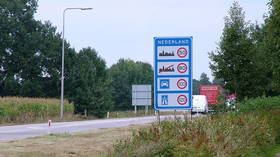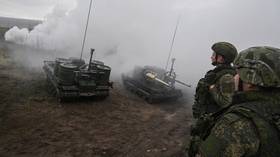Virtue-signalling or vehicular sense? Netherlands to lower speed limits to cut emissions - report

The government of the Netherlands will reportedly slash highway speed limits from 130 km/h (80mph) to 100 km/h (60mph) in a bid to curb nitrogen emissions. The move has been received with mixed feelings.
Dutch broadcaster NOS reported on Tuesday that the center-right/center-left coalition government will unveil the lowered speed limit on Wednesday morning. Prime Minister Mark Rutte did not confirm the news, telling reporters to wait overnight for the official word.
The drastically lowered speed limit will be enforced during daytime hours, and existing speed limits of 120 km/h and 130 km/h will remain in place between 7pm and 6am.
The government claims that the drop in speed limits will offset the nitrogen emissions of the 75,000 new homes it plans on building next year. Rutte’s cabinet will also reportedly reveal plans to add enzymes to cattle feed to cut down on the ammonia content of their manure.
Also on rt.com REALLY want to help Mother Nature? Don't drive electric cars, ignore paper bags & forget about organic foodThe bid to slash nitrogen and ammonia emissions comes after the Council of State ruled in May that construction and agriculture in the Netherlands emitted amounts of these substances in breach of EU legislation.
Efforts to tackle the problem have not gone down well though. Furious at being labelled a climate change threat, Dutch farmers blocked hundreds of miles of major roads with their tractors last month, causing a thousand-kilometer (620 mile) gridlock.
While Dutch media outlet NRC reported that a majority of its readers see the new limit as a “win-win situation,” not everyone is happy.
Also on rt.com Dutch farmers clog highways in protest at politicians labeling them climate change problem
“In Germany you can drive fast, you have an excellent gas connection, and you can fill your tank for cheaper,” on commenter wrote. “Can’t we become a province?”
Right-wing party Forum For Democracy (FvD) - which opposes the new limit - presented the choice between themselves and Rutte’s coalition as one between “progress or standstill.”
Vooruitgang of stilstand. Dat is de keus. https://t.co/Cyfw4Jb7gMpic.twitter.com/1fLuzOoAEX
— ForumvoorDemocratie (@fvdemocratie) November 12, 2019
Furthermore, Henk Stipdonk, a scientist with the Ministry of Infrastructure told Amsterdam-based newspaper Trouw that traffic only accounts for around six percent of the country’s nitrogen emissions. Additionally, he told the paper that “very little is still known in science” about the link between vehicles and nitrogen production.
The relation between speed and emissions is a massively complex one. Diesel engines emit less nitrogen at lower speeds, but more carbon. Gasoline engines, on the other hand, emit more nitrogen at lower speeds, but more carbon at higher speeds, according to a simplistic summary of EU research. Also at play is the efficiency of the engine in question - with newer units generally performing better - and the aerodynamic properties of the vehicle itself.
All in all, Stipdonk reckons that the new speed limits will only cut the Netherlands’ emissions by a tenth of a percentage point.
Also on rt.com First it was the cow farts, now asthmatic patients are killing the environment, says new studyIf introduced as reported, the Netherlands’ new speed limit will be the slowest in Europe, tied with Cyprus. Ironically, it was the United States - home of the gas-guzzling V8 - that first slashed speed limits in the name of cutting gasoline consumption.
A year after the 1973 Oil Crisis, the federal government introduced the National Maximum Speed Law, which cut speed limits across the US to 55mph (90km/h). Though the law was repealed in 1995, many states kept the 55mph restriction in place.
Gasoline savings as a result of the law were estimated at a mere 0.5 to one percent. Far more instrumental in lowering the US’ consumption was the ensuing popularity of smaller-engined, more efficient European and Japanese imports.
Like this story? Share it with a friend!
















